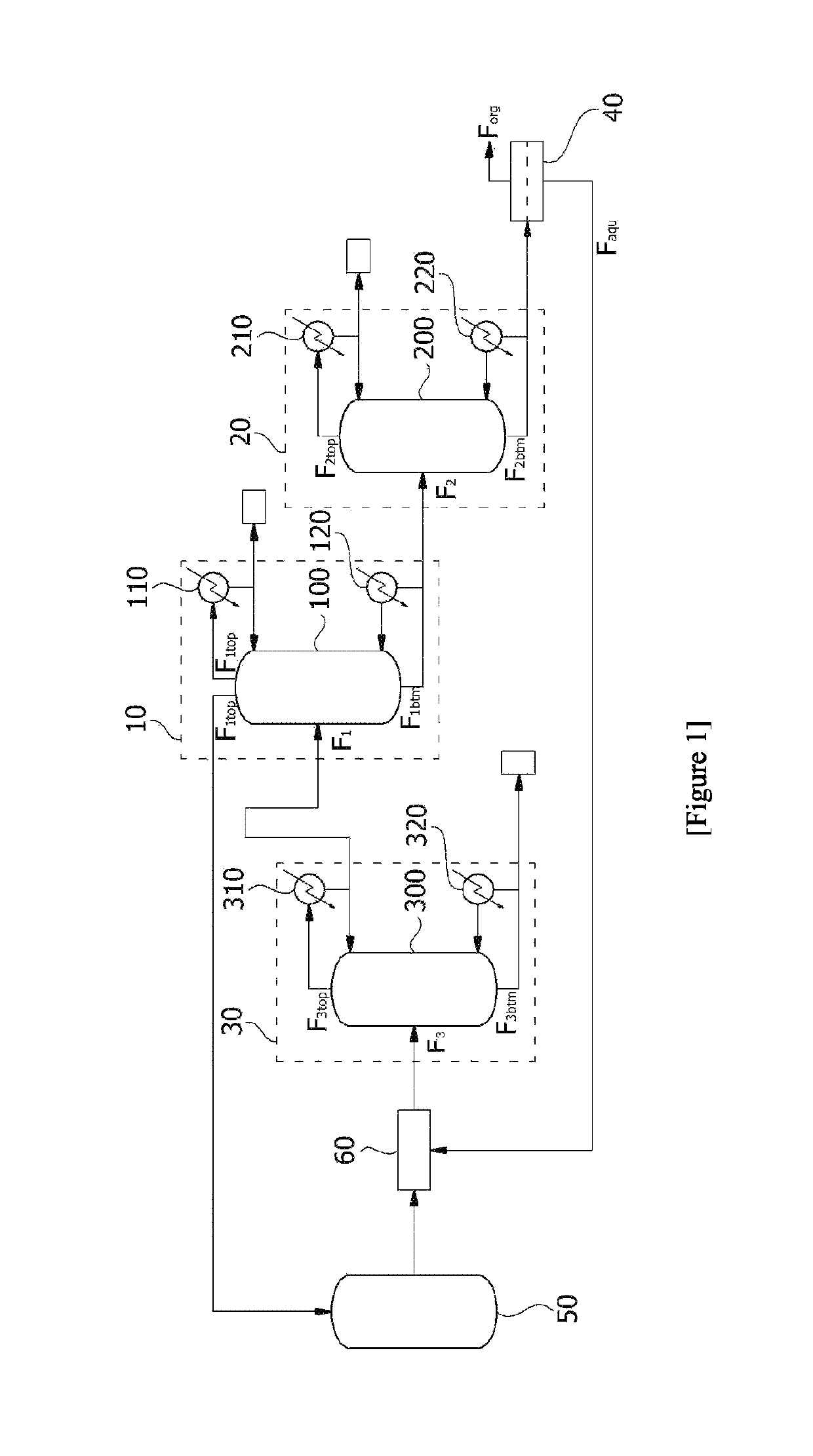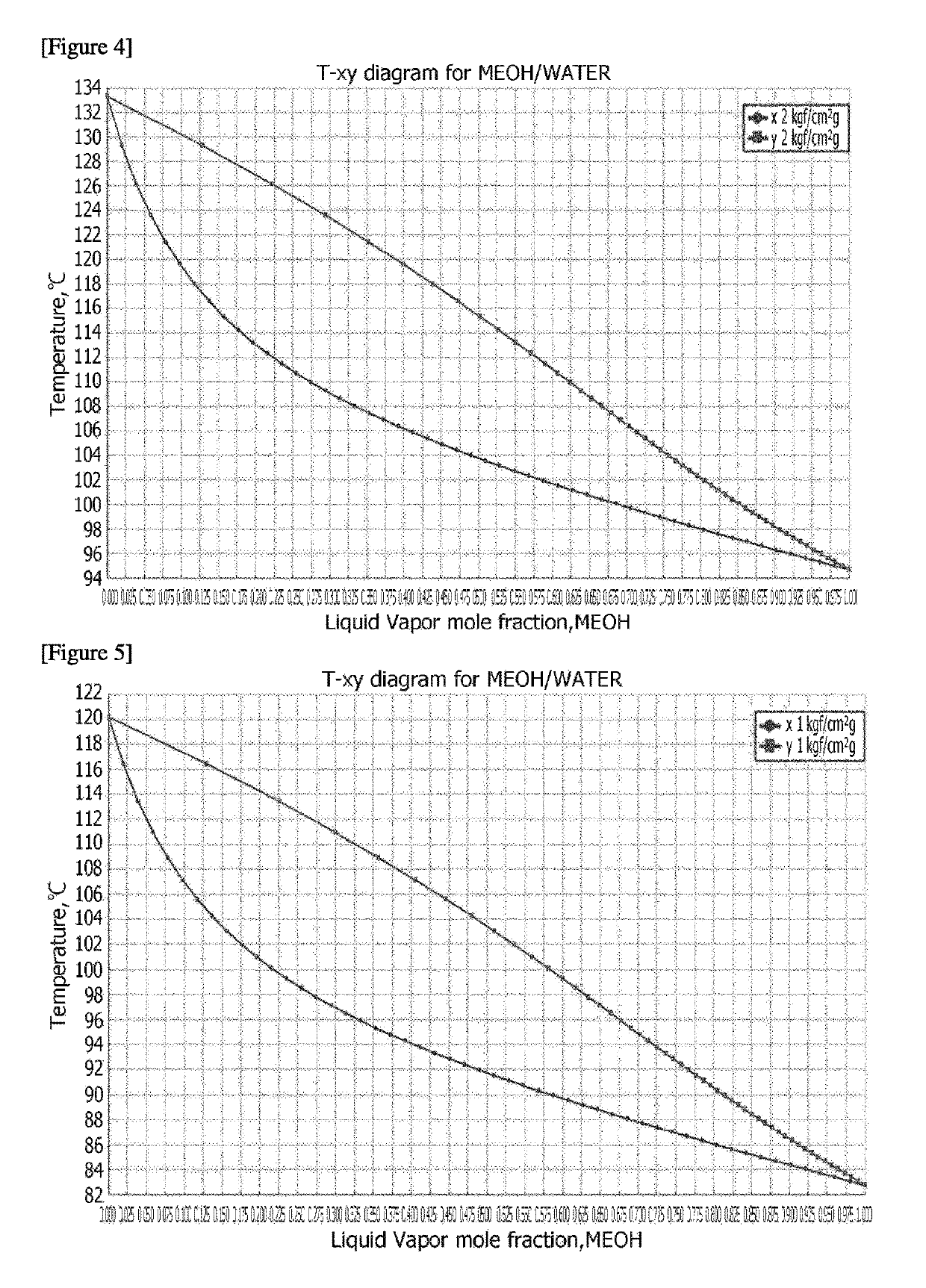Distillation device
a distillation device and distillation technology, applied in the field of distillation devices, can solve the problems of large increase in equipment equipment operating cost and equipment cost, relative difficulty in separating acetone and methanol, etc., and achieve the effect of reducing methanol content, facilitating methanol separation, and prolonging catalyst li
- Summary
- Abstract
- Description
- Claims
- Application Information
AI Technical Summary
Benefits of technology
Problems solved by technology
Method used
Image
Examples
example 1
[0130]Acetone and methanol were separated using the distillation device of FIG. 8.
[0131]Specifically, a feedstock containing 55% by weight of acetone, 22% by weight of cumene, 4% by weight of alpha-methylstyrene, 0.03% by weight of methanol, and 0.14% by weight of a high boiling point component was introduced into the first distillation column having a number of theoretical stages of 65 at a temperature of 88° C. and a flow rate of 43,000 kg / hr.
[0132]The first top flow discharged from the top region of the first distillation column passed through the first condenser and a portion was refluxed to the top region of the first distillation column. The remaining portion of the first top flow was separated and stored as a product comprising 99.8% by weight of acetone and 0.02% by weight of methanol, and the first bottom flow discharged from the bottom region of the first distillation column passed through the first reboiler, and a portion was refluxed to the bottom region of the first dis...
example 2
[0138]Acetone and methanol were separated by the same method as Example 1, except that the operating conditions of the second distillation column were changed as in Table 1 below.
[0139]In the case of separating acetone and methanol using the distillation device of Example 2, the used amount of energy in first and second reboilers and the removal rate of methanol were shown in Table 1 below.
example 3
[0140]Acetone and methanol were separated using the distillation device of FIG. 9.
[0141]Specifically, a feedstock containing 55% by weight of acetone, 22% by weight of cumene, 4% by weight of alpha-methylstyrene, 0.03% by weight of methanol, and 0.14% by weight of a high boiling point component was introduced into the first distillation column having a number of theoretical stages of 65 at a temperature of 88° C. and a flow rate of 43,000 kg / hr.
[0142]The first top flow discharged from the top region of the first distillation column passed through the first condenser and a portion was refluxed to the top region of the first distillation column. The remaining portion of the first top flow was separated and stored as a product comprising 99.8% by weight of acetone and 0.02% by weight of methanol, and the first bottom flow discharged from the bottom region of the first distillation column passed through the first reboiler, and a portion was refluxed to the bottom region of the first dis...
PUM
| Property | Measurement | Unit |
|---|---|---|
| temperature | aaaaa | aaaaa |
| temperature | aaaaa | aaaaa |
| temperature | aaaaa | aaaaa |
Abstract
Description
Claims
Application Information
 Login to View More
Login to View More - R&D
- Intellectual Property
- Life Sciences
- Materials
- Tech Scout
- Unparalleled Data Quality
- Higher Quality Content
- 60% Fewer Hallucinations
Browse by: Latest US Patents, China's latest patents, Technical Efficacy Thesaurus, Application Domain, Technology Topic, Popular Technical Reports.
© 2025 PatSnap. All rights reserved.Legal|Privacy policy|Modern Slavery Act Transparency Statement|Sitemap|About US| Contact US: help@patsnap.com



